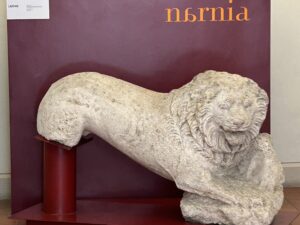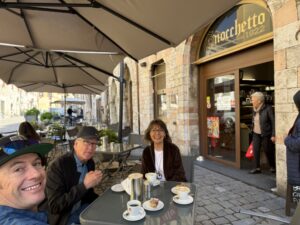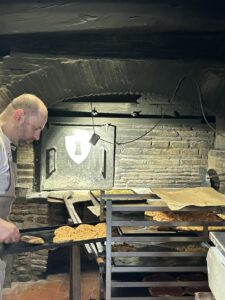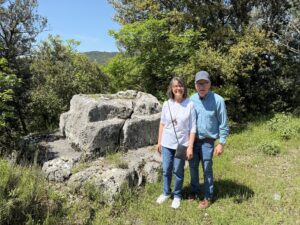“Are you going to Narnia?
Take me along with you
To meet the Lamb who is a Lion.
I want to learn to love Him too…”
(Song by The Second Chapter of Acts)
I can’t even remember where I first heard about the Italian medieval hilltop city of Narni, but when I did, I immediately knew I wanted to go there.
C.S. Lewis’s “Chronicles of Narnia” had impacted me, as well as our children, in a great way when we read them together so many, many years ago. “The Lion, the Witch, and the Wardrobe” is by far my favorite in the series because our life on this earth and the Christian faith are played out in such an understandable and exact way through the symbolism and allegory of the book. The character of Aslan the mighty Lion– a portrayal of Jesus Christ– still thrills me, and the story of his death on the ancient stone table that culminated in the mighty power of his resurrection, cracking the very foundation of the stone table, still takes my breath away.
After reading these stories to our children, the writings of C.S. Lewis became an unfolding pursuit for me, with a hunger to always find out more. There’s a whole shelf in my bookcase of his writings as well as his biography and autobiography (“Surprised by Joy.”) I’ve rewatched the excellent documentary by Max McLean of Lewis’s life, “The Most Reluctant Convert” multiple times, and just this week a DVD of his new film, “Further Up and Further In,” arrived in the mail– especially exciting because my husband, some grandsons, and I were in the live audience when it was filmed in Nashville.
In the summer of 2016, Dan and I enthusiastically traveled to Oxford, England to participate in a summer seminar on “The Life and Works of C.S.Lewis” sponsored by the C.S.Lewis Foundation, with lectures held right in Lewis’s home– The Kilns– and tours of all the places where he and his contemporaries, including Tolkien and the group of writers called the Inklings, spent so many hours of discussions.
Not long after, when we traveled to Belfast, Northern Ireland, Dan and I sought out a memorial park dedicated to Lewis who was born there. Statues of the Narnia characters– including the professor and the wardrobe itself– highlighted the park, with a replica of the stone table, and a huge steel statue of the powerful and majestic Aslan.
Consequently, you can imagine my excitement when not too long after we settled into our Italian home in Umbria, we learned of the nearby city of Narni which had originally been called Narnia. Lewis, of course, had never traveled to Italy, but as he was studying a Latin atlas, he came upon the name of this medieval hilltop city and was drawn to the sound of it. His Chronicles of Narnia took shape as he read about the ancient stone table in a remote setting outside the city wall. The stone table had been used in pre-Roman times for animal sacrifices, and after so many years, it was cracked… which became part of Lewis’s story.
In pursing more information about the town, I read that inside the courtyard leading into the town hall, in a building that dates back to 13th century, there is an old Roman stone statue of a lion, seeming to watch over justice and life in the town. Reading about these things stirred my desire to find this place.
Narni turned out to be only an hour’s drive from our house in Umbria, and we didn’t have to convince our friends Jeb and Sarah, who were visiting us at the time, to head out on this adventure with us. Jeb and Sarah are fellow Lewis fans, as eager as we were to find it. After reading about the town and yet knowing that it wasn’t very well known, I expected a rather small, insignificant place… remote… old, of course… perhaps run down a bit. I assumed it would be easy to find these landmarks, take some photos, and move on to other nearby towns to make our day complete. But like so many others of Italy’s medieval hilltop cities, Narni was a remarkable surprise. It’s incredibly beautiful, and so much bigger than I’d anticipated. It was all so clean, safe, lively, and friendly– honestly like a storybook fantasy. So perfect!
On the day we visited, the town was decked with flags lining the ancient stone buildings in preparation for their annual medieval festival. Shops, restaurants, houses, fountains were filled with life and vibrancy. We stopped at a cafe for cappuccinos so we could sit and absorb the beauty of the place. Then we were off to wander the ancient streets in search of the stone statue of the lion.
People were remarkably friendly in this non-touristy town, and were eager to help us. An elderly Italian woman seemed to know we were on a quest, and pointed us in the direction of the museum/town hall, chatting enthusiastically in Italian the whole time. We wandered in, expecting to pay a fee to enter the museum and search for the lion, but there it was in the entrance– regal and beautiful. The lion! We really were in Narnia!
After the thrill of finding the stone lion, we wandered the streets looking for a good place to stop for lunch. A young Italian woman overheard us talking in English and told us, in English, that she was missing her American friend who had just left after visiting her. She offered to take us to an authentic pizza place so we could have lunch the way the locals do. Obligingly, we followed her through the winding streets, up steep, lengthy stone stairways, and through narrow alleys to a tiny literal hole-in-the-wall that contained one of the oldest pizza ovens in Italy. The cook (“il cuoco”) turned out an amazing variety of delicious pizzas. We ordered several different kinds and found a table nearby where we shared our lunch in this stunning medieval setting.
With hunger satisfied, but not wanting to leave this place yet, we wandered through side streets and discovered a beautiful park with a breathtaking view of the deep valley surrounding the town. We meandered through streets of stone houses decked with gardens, flowers, and lush plants, but eventually we knew we had to start heading back… in search of the stone table. So reluctantly, we made our way back to the car– stopping at a bookstore to purchase a copy of “The Chronicles of Narnia” in Italian– and headed back out of town.
Without too much effort, following our GPS directions, Jeb parked the car outside the city on the narrow edge of a very busy, winding highway and we hiked carefully in single file along the busy road until suddenly, there it was… the beautiful, ancient, huge stone table, cracked through just as we had expected. The stone table was literally used so long ago for animal sacrifices and has stood through centuries of time. I felt giddy! This was so exciting!
As we made our way back home, we all felt invigorated with the adventure. It had been a far greater surprise than any of us had ever expected it to be. It was a reflection– however small– of a kind of longing we might have, and the joy of finding its fulfillment. Lewis himself wrote in his book Mere Christianity, “If I find in myself a desire which no experience in this world can satisfy, the most probable explanation is that I was made for another world… Earthly pleasures were never meant to satisfy it, but only to arouse it, to suggest the real thing.” The hilltop city of Narnia was one of those earthly pleasures, pointing to “the real thing.”
I’d often imagined what it would be like to “go to Narnia,” but I never imagined there could actually be a place called Narnia somewhere here on earth. And the biggest surprise of all? We found Narnia right here in the most unlikely place– in Italy!





Hello Susan! Cydney Polley here. Don’t know if you remember me but I’m Shannon’s mom. She told me about your purchase of a home in Italy and sent me your blog. I thoroughly enjoy it! She probably told you we have relatives there which we have been blessed to visit them several times. I’m hoping to next year!
I’ve been looking at places in Italy for sale for years but not feasible for now. I’m not getting any younger and Terry is in poor health. Your place looks amazing! Ciao for now💜